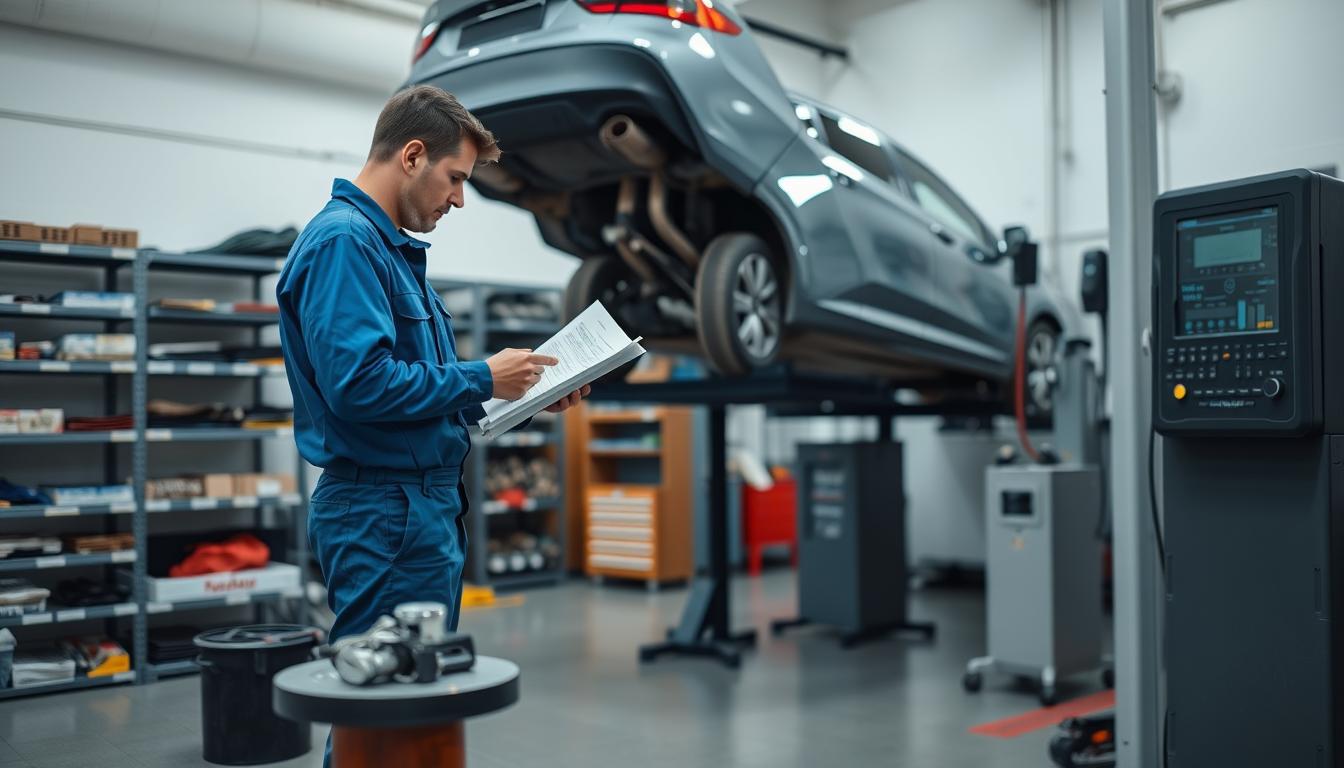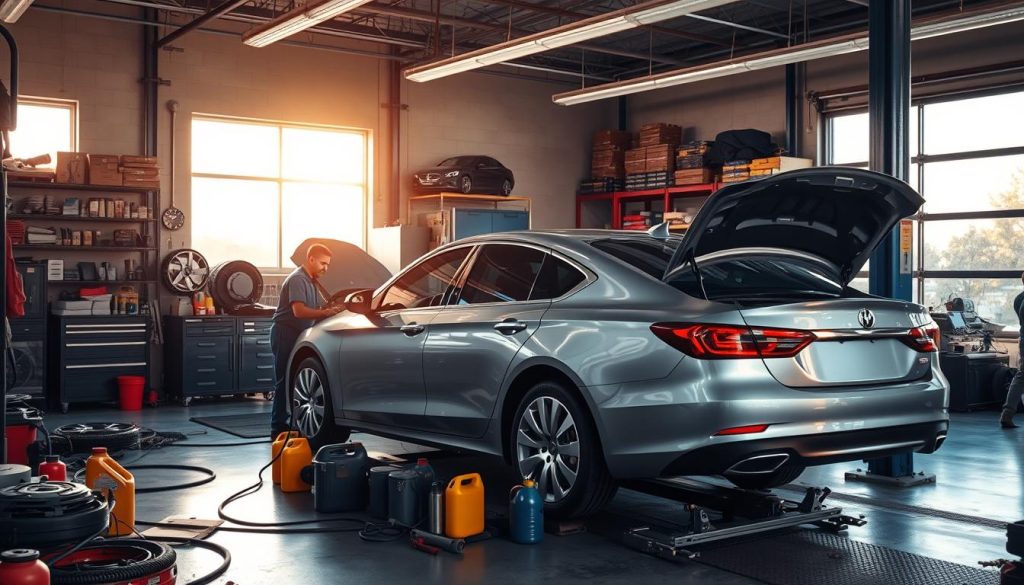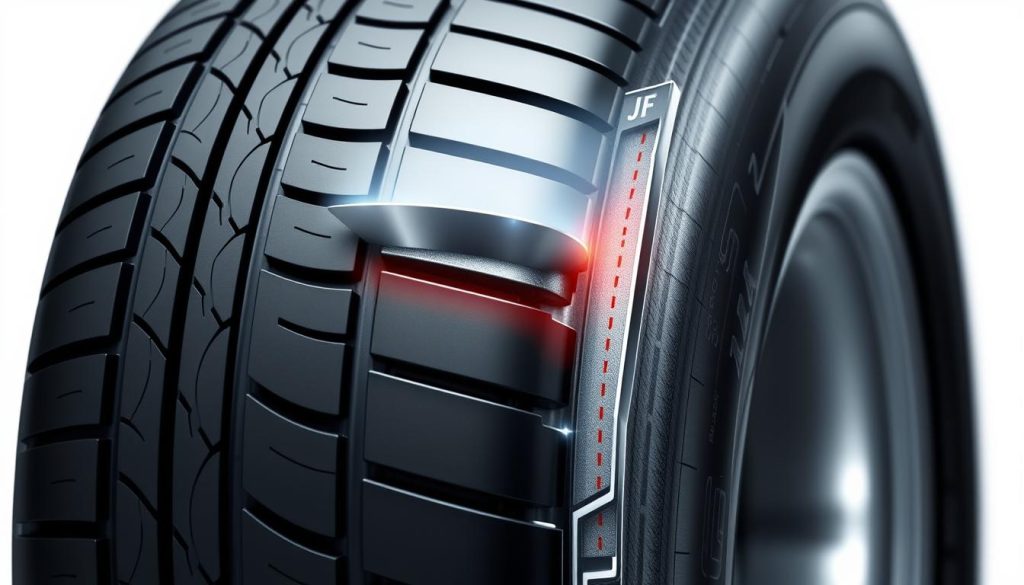Passing a vehicle’s emissions test is key for the environment and the law. In San Antonio, like New York, tests check if our cars are safe and clean. Knowing about our car’s timing belt is important to avoid big engine problems and expensive fixes.
A good timing belt helps the engine run smoothly. It keeps the pistons and valves working together. If we don’t replace it on time, our car might break down and cause serious engine trouble.
In this article, we’ll talk about how to get our cars ready for emissions tests. We’ll also cover why tests might fail and how to pass with ease.
Key Takeaways
- Understanding emissions testing requirements in your state is essential.
- Regular maintenance, including timing belt checks, helps prevent major issues.
- The “Check Engine” light must be off to avoid automatic failure.
- Many emissions failures can be traced back to minor issues like a faulty gas cap.
- Pre-test vehicle inspections can improve our chances of a successful test.
Understanding Emissions Testing in San Antonio
Emissions testing checks how much pollution our cars make. It makes sure we follow local rules. It looks at how well our cars control harmful gases.
In San Antonio, cars must pass a yearly check. This is important for keeping our air clean.
What Is Emissions Testing?
Emissions testing checks how much pollution our cars make. Experts look at many parts, like the fuel system. They make sure harmful gases are kept out of the air.
If our cars don’t pass, we might get fined. We could also have trouble registering our car in San Antonio.
Why Do We Need Emissions Testing?
Emissions testing is more than just following rules. It helps keep our air clean and protects our health. It also makes us take better care of our cars.
By keeping our cars in good shape, we can lower pollution. This makes our community a healthier place.
Preparing Our Vehicle for Emissions Testing
Getting our vehicle ready for emissions testing is key. We start with regular car care to make sure everything works right. This helps our engine run better and lowers the chance of failing the test.
Regular checks can really help us do well on test day.
Routine Maintenance That Matters
Regular car care is very important for emissions testing. Here are some things to add to our checklist:
- Regular oil changes keep the engine running smoothly.
- Changing air filters helps with airflow and engine performance.
- Spark plugs need checking for good combustion.
- Catalytic converters and oxygen sensors are key for emissions.
Keeping these parts in good shape helps us pass the test. If our dashboard lights up, fix those problems before the test.
Checking Our Vehicle’s Components
It’s also important to check different parts of our vehicle. This makes sure our engine works well and meets test standards. We should focus on:
- The fuel system should have no leaks to reduce emissions.
- A good battery is needed for tests to work right.
- The fuel tank should be between 30% and 70% full for testing.
- Doing a drive cycle to get ready for the test.
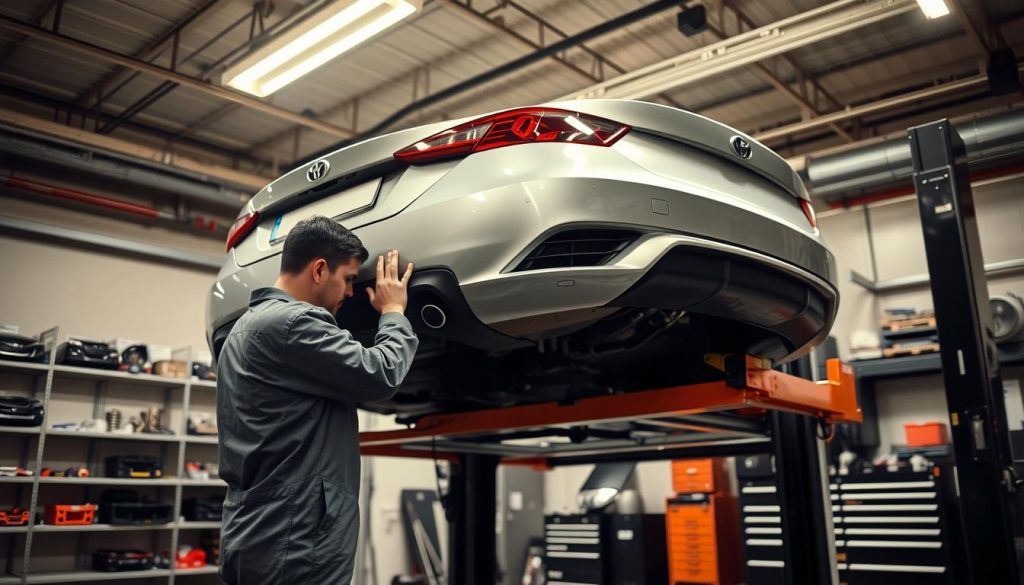
Doing these checks helps us know our car is ready for the test. When we prepare well, we’re more likely to pass the test the first time.
Common Reasons for Failed Emissions Tests
Knowing why emissions tests fail helps us get our cars ready. Problems like bad engine performance and fuel system issues are common. Finding these problems early lets us fix them before the next test.
Poor Engine Performance
Poor engine performance means more emissions, leading to test failures. Signs include misfires and rough idling. These might mean the ignition or fuel system needs fixing.
When our engine doesn’t perform well, it emits more harmful gases. This is bad for gas-burning vehicles.
Fuel System Issues
Fuel system problems are a big reason for test failures. Clogged fuel injectors or a bad fuel pump can mess up the air-fuel mix. This leads to more carbon dioxide and carbon monoxide.
If our car uses more fuel or idles roughly, check the fuel system. It might need fixing.
Faulty Emission Control Devices
Emission control devices, like catalytic converters and oxygen sensors, are key. A bad catalytic converter can cause big test failures, shown by codes P0420 or P0430. Faulty oxygen sensors also increase emissions.
Ignoring these issues hurts our test scores and can damage the engine more.
Tips for Passing Emissions Tests
Getting ready for emissions tests needs careful planning and upkeep. Using smart strategies can really help us pass. We look at doing good pre-test checks and getting help when we need it.
Recommended Pre-Test Inspections
Doing detailed pre-test checks is key for passing. Here’s what we should do:
- Check the vehicle’s onboard diagnostics (OBD-II) for any trouble codes.
- Make sure all emission systems, like the catalytic converter and EGR system, work right.
- Drive the car a few days before to make sure the engine gets hot enough.
- Change old spark plugs and check the air filter. These affect fuel use and emissions.
- Make sure the gas cap is tight and not leaking. A bad cap can cause a fail.
Utilizing Professional Help
When unsure, getting help from experts is very helpful. Certified mechanics can:
- Do deep diagnostics to find problems before the test.
- Tell us what repairs are needed to meet emissions rules.
- Fix any warning lights, as a glowing check engine light means an automatic fail.
- Help us fix things that can be done on the same day as the test.
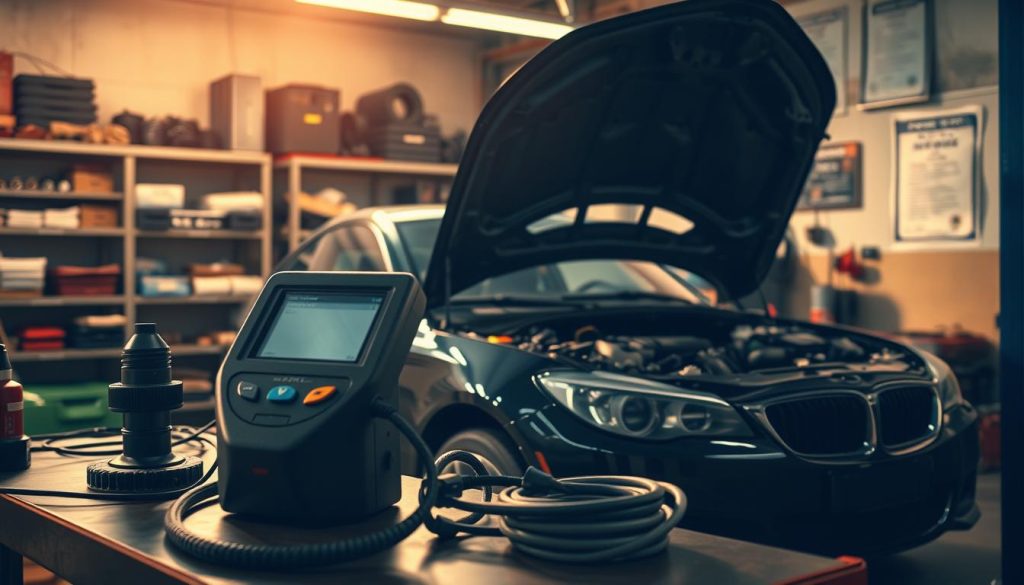
The Role of OBD-II Diagnostics in Emissions Testing
The On-Board Diagnostics II (OBD-II) system is key for our cars to meet emissions rules. It checks engine performance and emissions. This helps us pass emissions tests and keep our cars clean.
What Is OBD-II?
OBD-II is a smart system for car checks. It started in 1996 for U.S. cars. It watches how well the car works, including emissions.
This system lights up the check engine light if it finds problems. It’s important because it finds issues that can make cars pollute more.
How OBD-II Affects Our Emissions Test
OBD-II is very important during emissions tests. It shows real-time data on emissions. Cars made after 2000 often get checked this way.
If OBD-II finds a problem, it can fail the test. Knowing how to read OBD-II helps fix issues before the test. This makes passing the test more likely.
Cars that are PZEV or SULEV get longer warranties. This includes coverage for OBD-II problems. It shows how OBD-II keeps cars running well and clean.
Taking Action If We Fail the Emissions Test
After a failed emissions test, we need to know what to do. The test shows why we failed. It might be small fixes or big repairs.
Knowing why helps us fix it right. This makes sure our car meets the rules.
Understanding Our Options
When we fail, we have many repair choices. First, we should:
- Look at the test results.
- Find out why, like bad sensors or lights.
- Talk to a good mechanic about fixing it.
Fixing problems early can save us money. This way, we can pass the test easily. It also helps us follow the law and avoid fines.
Steps to Repair and Retest
After picking our repair plan, we can start fixing and testing again. Here’s what to do:
- Fix what’s broken, like parts that wear out.
- Make sure all emissions parts work right.
- Drive for 20 minutes to warm up the converter.
- Get a new emissions test at a certified place.
Fixing big problems, like the PCM, helps us pass the test. Regular car care keeps us from failing. It keeps us in line with emissions rules.
Staying Informed About Emission Regulations
As vehicle owners in San Antonio, we must stay updated on emission regulations updates. The U.S. Environmental Protection Agency (EPA) will introduce new guidelines in 2027. These will target nitrogen oxides (NOx) emissions from diesel-powered trucks.
This change means we may need to prepare for stricter compliance requirements. We must ensure our vehicles meet the new standards.
Keeping up with San Antonio emissions information is key. Local organizations like the Texas Commission on Environmental Quality (TCEQ) often provide updates. They share details on testing procedures and compliance mandates.
We should actively seek these resources. This way, we can stay informed about any deadlines and costs for new regulations. Industry insights suggest production costs for trucks could rise by $25,000 to $30,000.
It’s also wise to connect with industry professionals and community forums. They discuss vehicle compliance related to emissions. By engaging with these resources, we can understand the implications of new regulations.
Staying informed helps us navigate these changes. It also promotes cleaner air and a healthier environment for our community.

